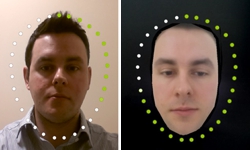
Phones like the Samsung Galaxy can use facial recognition rather than typing in a security code. The problem is you will end up taking twice as long quite often, because the facial recognition will fail and you type in a PIN anyway. The system is good at rejecting impostors - and also the owner.
What might help is 'morphing' together several photos for the software to analyze, so that users store an 'averaged' picture of themselves.
A research team led by Dr. David Robertson of the University of York Department of Psychology's FaceVar laboratory found that combining different pictures of the user, rather than a single 'target' image, leads to much better recognition across all kinds of daily settings.
It is understood that the brain forms abstract representations of the faces it knows, and that people are very good at recognizing their family and friends over a range of conditions - and that computers are not. If it is possible to copy these representations, then automatic face recognition can improve. Using 'average' images is a simple way to do this and they found that performance could be greatly improved, often to perfect levels, if users stored an 'average' of their own photos - formed by morphing together several different photos of the user.
Robertson said, 'We chose to study the Samsung Galaxy because it is a very popular phone which comes with working face recognition technology. However, we expect this technique to work across a wide range of phones and other automated recognition devices. It is very interesting that performance can be so much improved by copying a simple trick performed by the brain."
Citation: Robertson, D. J., Kramer, R. S. S., Burton, A. M. (2015). Face averages enhance user recognition for smartphone security. PLoS ONE, 10(3): e0119460. Image credit: University of York





Comments